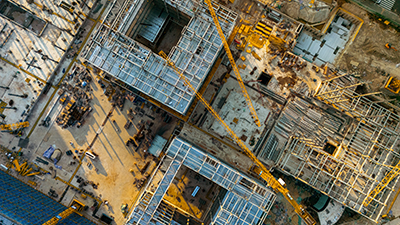
Real estate industry undergoing transformation
With digital planning expertise and a future-oriented mindset.

Air quality in Chinese metropolitan areas is poor. A few years ago, the government of the People’s Republic recognised this and adopted an action plan for many regions. In this way, by 2018 it was possible to reduce the concentration of particulate matter in the 74 largest cities and metropolitan regions by 40%. Nevertheless, smog levels in Beijing and Shanghai, for example, are still often 20 times higher than the limits recommended by the World Health Organization (WHO) today – a challenge for modern facility management.

China is on its way to becoming a world power. The Middle Kingdom is already the second largest economy in the world. As economic output increases, so do the energy requirements of the country and its 1.4 billion inhabitants. However, more than 80% of the energy needed is derived from coal and oil. This makes China by far the largest carbon dioxide emitter in the world, with consequences that can be dramatic for the global and local environment. In particular, the conurbations in the east of the country, where 90% of the Chinese population live, are affected by this development.

The result is a significantly increased risk of cardiovascular disease. Worldwide, it is estimated that between four and six million people die as a result of air pollution – more than a million in China alone. In 2014, the Chinese state launched extensive countermeasures. In this way, by 2018 it was possible to reduce the concentration of particulate matter in the 74 largest Chinese cities and metropolitan regions by 40%. Although that sounds like a success, it is far from enough. Even now, the limit values are often significantly exceeded. For that reason, many city dwellers only leave the house wearing a respiratory mask.
But indoors, too, protection from smog is a big issue. With the help of the M&P Group, it was possible to significantly improve the air quality in the offices of Siemens China – thanks to extensive measurements of the air conditioning systems and in the offices, with specially flown-in measuring equipment. This allowed improvements to be developed that could be immediately analysed and evaluated on-site. A smartphone app made the project visible and comprehensible for the 5,000 or so Siemens employees, too: based on sensor data collected at various points in the building, the app displays the air quality inside and outside the building in real time.

Large displays have also been installed in the foyers of the larger Siemens buildings, informing all visitors about the air purity inside. Ekaterina Zhukova, one of the M&P managers on-site, recalls: ‘The explanation of the technical details to our local contacts was not always problem-free, but the implementation – with the help of some gestures – has paid off: true to the Chinese proverb, we have brought a little light, or better air, into the dark of China’s offices, which often suffered from poor air quality.’
However, in China and many other regions of the world, there is still a lot of room for improvement when it comes to particulate matter and smog levels. We are ready to help, and support improved health and quality of life with innovative solutions.

With digital planning expertise and a future-oriented mindset.

How innovative engineering at the new Nationale Referenzzentrum ensures safe research of the tuberculosis pathogen.

Intelligent, effective and sustainable solutions are crucial for the future of modern metropolises.